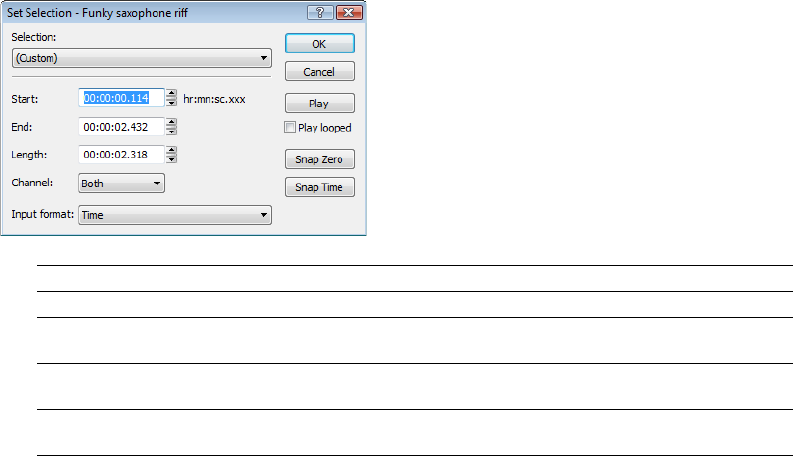
Selecting audio using start and end values
You can select audio by dragging the mouse or by using keyboard shortcuts. (For more information, see Data selection shortcuts on page 331.)
For the sake of accuracy, however, it is often useful to create selections by entering specific start and end point values. The Set Selection dialog
allows you to create selections in this way or by choosing a preset selection from the Selection drop-down list.
1.
From the Edit menu, choose Selection, and then choose Set from the submenu (or press Ctrl+Shift+D). The Set Selection dialog
appears.
2.
From the Input format drop-down list, choose the format to be used for creating the selection. The values in the Start, End, and
Length boxes change to reflect the specified format.
3.
Configure the selection by typing appropriate values in the Start and End or the Start and Length boxes.
4.
If you are working with a stereo file, choose Left, Right, or Both from the Channel drop-down list, or, for a multichannel file, type
the appropriate channel numbers in the Channel box.
5.
Click OK.
Using the Set Selection dialog
The following sections briefly describe additional controls located in the Set Selection dialog.
Control Description
Play Clicking Play plays the current selection.
Play looped Selecting the Play looped check box allows you to play the selection in Looped
Playback mode.
Snap Zero Clicking Snap Zero forces the Start and End values of the selected area to the next
zero-crossing.
Snap Time Clicking Snap Time forces the Start and End values of the selected area to a whole
time division as designated by the markings on the data window’s time ruler.
Zero-crossing preference
When using a Snap Zero command, you can configure the application to snap to positive slope, negative slope, or either slope zero-
crossings.
1.
From the Options menu, choose Preferences, and click the Editing tab.
2.
From the Snap to zero-crossing slope drop-down list, choose the desired slope and click OK.
92
| CHAPTER 4
